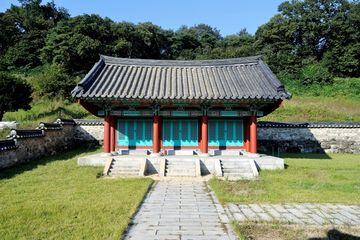"효자 오백주 정문"의 두 판 사이의 차이
| 30번째 줄: | 30번째 줄: | ||
===영문=== | ===영문=== | ||
| − | '''Commemorative Plaque of O Baek-ju''' | + | '''Commemorative Plaque of O Baek-ju for His Filial Devotion''' |
This is the plaque commemorating the filial-piety of O Baek-ju (1643-1720), an official of the Joseon period (1392-1910). These commemorative plaques were intended to be hung on red gates that were built before the houses of filial sons and daughters, but this one is currently stored in this pavilion for preservation. | This is the plaque commemorating the filial-piety of O Baek-ju (1643-1720), an official of the Joseon period (1392-1910). These commemorative plaques were intended to be hung on red gates that were built before the houses of filial sons and daughters, but this one is currently stored in this pavilion for preservation. | ||
2020년 7월 5일 (일) 00:29 판
| 효자 오백주 정문 |
|
| 대표명칭 | 효자 오백주 정문 |
|---|---|
| 한자 | 孝子 吳伯周 㫌門 |
| 주소 | 경기도 포천시 정문동1길 38 (어룡동) |
| 지정번호 | 포천시 향토유적 제3호 |
| 지정일 | 1986년 4월 9일 |
| 소유자 | 사유 |
|
|
|
해설문
국문
조선 숙종 때 효자 오백주(吳伯周:1643~1720)의 효행을 국가에서 기리기 위해 내린 정문이다. 정문은 열녀와 충신, 효자의 집 앞에 세우는 붉은 문이다.
오백주는 인조 21년(1643) 어룡동에서 출생하였으며, 23세에 무과 급제 후 구성도호부사를 지내면서 청렴하다는 평을 들었다. 효성이 지극하여 아버지의 병을 고치기 위해 지성으로 하늘에 기도하였고 산삼과 꿀을 구해 아버지의 병을 낫게 하였다. 이때 바위에 축원을 드렸던 고개를 축석령(祝石嶺)이라고 부르게 되었다고 한다. 이러한 그의 효행을 국가에서 높이 인정하여 효행자로 선정하고, 경종 3년(1723)에 정문을 내렸다.
그 후 동네 입구로 옮기고 나서 훼손되었던 것을 1954년에 중수하고, 1993년 원래의 위치로 옮기면서 사당과 정려각도 건립하였다. 정려각 내부 한가운데에 오백주의 정문이 있다. 오른쪽에는 증손 오수진(吳壽晋)과 부인 인천이씨의 효자 · 열녀 정문이 있고, 왼쪽에는 증조 오몽량(吳夢亮)의 부인 문화유씨의 열녀 정문이 있다.
영문
Commemorative Plaque of O Baek-ju for His Filial Devotion
This is the plaque commemorating the filial-piety of O Baek-ju (1643-1720), an official of the Joseon period (1392-1910). These commemorative plaques were intended to be hung on red gates that were built before the houses of filial sons and daughters, but this one is currently stored in this pavilion for preservation.
O Baek-ju passed the state examination at the age of 23 and became a civil official. He was well known for his integrity and also was a filial son. When his father got sick, he earnestly prayed to Heaven day and night and sought after wild ginseng and honey, which was believed to have healed his father. Since then, the place where he prayed, a stone upon a hill, has been called “a prayer stone hill.” The government acknowledged his filial actions and bestowed the plaque in 1723.
This plaque was once relocated to the village entrance. Due to damages, the plaque underwent a repair work in 1954, and was again moved to the original location, with the shrine and the pavilion newly erected at that time to house it. Currently, the plaque is displayed at the center inside the pavilion. To the right is the plaque commemorating his great-grand son, O Su-jin and his wife, and the other plaque to the left is for his great-grandmother, Lady Yu from the Munhwa Yu Clan.
- 제목에 정문이라고 되어있는데, commemorative gate으로 할지, plaque라고 해야 할지 모르겠어서 고민하다가 앞부분에 설명을 추가했어요. 현장 사진을 보니 gate라고 번역하면 오해할 것 같아서요...
